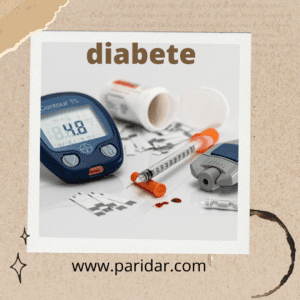Central diabetes insipidus a metabolic disorder due to injury of the neurohypophyseal system, which results in a deficient quantity of antidiuretic hormone (ADH or vasopressin) being released or produced, resulting in failure of tubular reabsorption of water in the kidney. As a consequence, there is the passage of a large amount of urine having a low specific gravity, and great thirst; it is often attended by voracious appetite, loss of strength, and emaciation. Diabetes insipidus may be acquired through infection, neoplasm, trauma, or radiation injuries to the posterior lobe of the pituitary gland or it may be inherited or idiopathic.
Thank you for reading this post, don't forget to subscribe!Treatment of pituitary diabetes insipidus consists of administration of vasopressin. A synthetic analogue of vasopressin (DDAVP) can be administered as a nasal spray, providing antidiuretic activity for 8 to 20 hours, and is currently the drug of choice. Patient care includes instruction in self-administration of the drug, its expected action, symptoms that indicate a need to adjust the dosage, and the importance of follow-up visits. Patients with this condition should wear some form of medical identification at all times.
gestational diabetes diabetes mellitus with onset or first recognition during pregnancy, usually during the second or third trimester. In some cases mild, undetected glucose intolerance was present before pregnancy. It often disappears after the end of the pregnancy, but many women with this condition develop permanent diabetes mellitus in later life. Although the disordered carbohydrate metabolism is usually mild, prompt detection and treatment are necessary to avoid fetal and neonatal morbidity and mortality.
maturity-onset diabetes of youth (MODY) an autosomal dominant variety of type 2 diabetes mellitus characterized by onset in late adolescence or early adulthood.
diabetes mel´litus a broadly applied term used to denote a complex group of syndromes that have in common a disturbance in the oxidation and utilization of glucose, which may be secondary to a malfunction of the beta cells of the pancreas, whose function is the production and release of insulin. Because insulin is involved in the metabolism of carbohydrates, proteins, and fats, diabetes is not limited to a disturbance of glucose homeostasis alone. Insulin resistance may also sometimes play a role in the etiology of diabetes.
The American Diabetes Association sponsored an international panel in 1995 to review the literature and recommend updates of the classification of diabetes mellitus. The definitions and descriptions that follow are drawn from the Report of the Expert Committee on the Diagnosis and Classification of Diabetes Mellitus. The report was first approved in 1997 and modified in 1999. Although other terms are found in older literature and remain in use, their use in current clinical practice is inappropriate. Epidemiologic and research studies are facilitated by use of a common language.
The Expert Committee notes that most cases of diabetes fall into two broad categories, which are called Type 1 and Type 2. There are also other specific types, such as gestational diabetes and impaired glucose homeostasis. See table for definitions of types of diabetes mellitus.
Incidence and Prevalence. It has been estimated that slightly over 6 per cent of the population is affected by some form of diabetes, or 17 million people in the USA and 1.2 to 1.4 million in Canada; many of these individuals are not diagnosed. Diabetes is ranked third as a cause of death, although the life span of patients with diabetes has increased due to improved methods of detection and better management. There is no cure for diabetes at the present time, but enormous strides have been made in the control of the disease. The patient must understand the importance of compliance with the entire treatment plan, including diet, exercise, and in some cases medication. The patient with diabetes is at increased risk for cardiovascular disease, renal failure, neuropathies, and diabetic retinopathy. Research studies such as the Diabetes Control and Complications Trial have indicated that tight control of blood glucose levels resulted in the delay or prevention of retinopathy, nephropathy, and neuropathy.
Diagnosis. The most common diagnostic tests for diabetes are chemical analyses of the blood such as the fasting plasma glucose. Capillary blood glucose monitoring can be used for screening large segments of the population. Portable equipment is available and only one drop of blood from the fingertip or earlobe is necessary. Capillary blood glucose levels have largely replaced analysis of the urine for glucose. Testing for urinary glucose can be problematic as the patient may have a high renal threshold, which would lead to a negative reading for urinary glucose when in fact the blood glucose level was high.
Clinical Manifestations. Diabetes mellitus can present a wide variety of symptoms, from none at all to profound ketosis and coma. If the disease manifests itself late in life, patients may not know they have it until it is discovered during a routine examination, or when the symptoms of chronic vascular disease, insidious renal failure, or impaired vision cause them to seek medical help.
The typical symptoms of diabetes mellitus are the three “polys:” polyuria, polydipsia, and polyphagia. Because of insulin deficiency, the assimilation and storage of glucose in muscle adipose tissues, and the liver is greatly diminished. This produces an accumulation of glucose in the blood and creates an increase in its osmolarity. In response to this increased osmotic pressure there is depletion of intracellular water and osmotic diuresis. The water loss creates intense thirst and increased urination. The increased appetite (polyphagia) is not as clearly understood. It may be the result of the body’s effort to increase its supply of energy foods even though eating more carbohydrates in the absence of sufficient insulin does not meet the energy needs of the cells.
Fatigue and muscle weakness occur because the glucose needed for energy simply is not metabolized properly. Weight loss in type 1 diabetes patients occurs partly because of the loss of body fluid and partly because in the absence of sufficient insulin the body begins to metabolize its own proteins and stored fat. The oxidation of fats is incomplete, however, and the fatty acids are converted into ketone bodies. When the kidney is no longer able to handle the excess ketones the patient develops ketosis. The overwhelming presence of the strong organic acids in the blood lowers the pH and leads to severe and potentially fatal ketoacidosis.
The metabolism of body protein when sufficient amounts of insulin are not available causes an elevated blood urea nitrogen. This first occurs because the nitrogen component of protein is discarded in the blood when the body metabolizes its own proteins to obtain the glucose it needs.
Persons with diabetes are prone to infection, delayed healing, and vascular disease. The ease with which poorly controlled diabetic persons develop an infection is thought to be due in part to decreased chemotaxis of leukocytes, abnormal phagocyte function, and diminished blood supply because of atherosclerotic changes in the blood vessels. An impaired blood supply means a deficit in the protective defensive cells transported in the blood. Excessive glucose allows organisms to grow out of control.
Another manifestation of diabetes mellitus is visual disturbance due to increased osmolarity of the blood and accumulation of fluid in the eyeball, which changes its shape. Once the diabetes is under control, visual problems should abate. Persistent vaginitis and urinary tract infection also may be symptoms of diabetes in females.
Sequelae. The long-term consequences of diabetes mellitus can involve both large and small blood vessels throughout the body. That in large vessels is usually seen in the coronary arteries, cerebral arteries, and arteries of the lower extremities and can eventually lead to myocardial infarction, stroke, or gangrene of the feet and legs. atherosclerosis is far more likely to occur in persons of any age who have diabetes than it is in other people. This predisposition is not clearly understood. Some believe that diabetics inherit the tendency to develop severe atherosclerosis as well as an aberration in glucose metabolism, and that the two are not necessarily related. There is strong evidence to substantiate the claim that optimal control will mitigate the effects of diabetes on the microvasculature, particularly in the young and middle-aged who are at greatest risk for developing complications involving the arterioles. Pathologic changes in the small blood vessels serving the kidney lead to nephrosclerosis, pyelonephritis, and other disorders that eventually result in renal failure. Many of the deaths of persons with type 1 diabetes are caused by renal failure.
Visual impairment and blindness are common sequelae of uncontrolled diabetes. The three most frequently occurring problems involving the eye are diabetic retinopathy, cataracts, and glaucoma. photocoagulation of destructive lesions of the retina with laser beams can be used to delay further progress of pathologic changes and thereby preserve sight in the affected eye.
Another area of pathologic changes associated with diabetes mellitus is the nervous system (diabetic neuropathy), particularly in the peripheral nerves of the lower extremities. The patient typically experiences a “stocking-type” anesthesia beginning about 10 years after the onset of the disease. There may eventually be almost total anesthesia of the affected part with the potential for serious injury to the part without the patient being aware of it. In contrast, some patients experience debilitating pain and hyperesthesia, with loss of deep tendon reflexes.
Other problems related to the destruction of nerve tissue are the result of autonomic nervous system involvement. These include impotence, orthostatic hypotension, delayed gastric emptying, diarrhea or constipation, and asymptomatic retention of urine in the bladder.
Mpparidar, [۱۶/۰۸/۲۰۲۲ ۰۷:۴۹ ب.ظ]
Although age of onset and length of the disease process are related to the frequency with which vascular, renal, and neurologic complications develop, there are some patients who remain relatively free of sequelae even into the later years of their lives. Because diabetes mellitus is not a single disease but rather a complex constellation of syndromes, each patient has a unique response to the disease process.
Management. There is no cure for diabetes; the goal of treatment is to maintain blood glucose and lipid levels within normal limits and to prevent complications. In general, good control is achieved when the following occur: fasting plasma glucose is within a specific range (set by health care providers and the individual), glycosylated hemoglobin tests show that blood sugar levels have stayed within normal limits from one testing period to the next, the patient’s weight is normal, blood lipids remain within normal limits, and the patient has a sense of health and well-being.
The protocol for therapy is determined by the type of diabetes; patients with either type 1 or type 2 must pay attention to their diet and exercise regimens. Insulin therapy may be prescribed for patients with type 2 diabetes as well as any who are dependent on insulin. In most cases, the type 2 diabetes patient can be treated effectively by reducing caloric intake, maintaining target weight, and promoting physical exercise.
Diet. In general, the diabetic diet is geared toward providing adequate nutrition with sufficient calories to maintain normal body weight; the intake of food is adjusted so that blood sugar and serum cholesterol levels are kept within acceptable limits. Overweight diabetic patients should limit caloric intake until target weight is achieved. In persons with type 2 diabetes this usually results in marked improvement and may eliminate the need for drugs such as oral hypoglycemic agents.
The patient, physician, nurse, and dietician must carefully evaluate the patient’s life style, nutritional needs, and ability to comply with the proposed dietary prescription. There are a variety of meal planning systems that can be used by the patient with diabetes; each has benefits and drawbacks that need to be evaluated in order to maximize compliance. Two of the most frequently used ones are the exchange system (see accompanying table) and the carbohydrate counting system.
In the exchange system, foods are divided into six food groups (starch, meat, vegetable, fruit, milk, and fat) and the patient is taught to select items from each food group as ordered. Items in each group may be exchanged for each other in specified portions. The patient should avoid concentrated sweets and should increase fiber in the diet. Special dietetic foods are not necessary. Patient teaching should emphasize that a diabetic diet is a healthy diet that all members of the family can follow.
The carbohydrate counting system focuses on matching the unit of insulin to the total number of grams of carbohydrate in food eaten. This system is the most accurate method for calculating insulin to food intake.
It is especially important that persons with diabetes who are taking insulin not skip meals; they must also be sure to eat the prescribed amounts at the prescribed times during the day. Since the insulin-dependent diabetic needs to match food consumption to the available insulin, it is advantageous to increase the number of daily feedings by adding snacks between meals and at bedtime.
Exercise. A program of regular exercise gives anyone a sense of good health and well-being; for persons with diabetes it gives added benefits by helping to control blood glucose levels, promoting circulation to peripheral tissues, and strengthening the heart beat. In addition, there is evidence that exercise increases the number of insulin receptor sites on the surface of cells and thus facilitates the metabolism of glucose. Many specialists in diabetes consider exercise so important in the management of diabetes that they prescribe rather than suggest exercise.
Persons with diabetes who take insulin must be careful about indulging in unplanned exercise. Strenuous physical activity can rapidly lower their blood sugar and precipitate a hypoglycemic reaction. For a person whose blood glucose level is over 250 mg/dl, the advice would be not to exercise at all. At this range, the levels of insulin are too low and the body would have difficulty transporting glucose into exercising muscles. The result of exercise would be a rise in blood glucose levels.
Insulin Therapy. Exogenous insulin is given to patients with diabetes mellitus as a supplement to the insufficient amount of endogenous insulin that they produce. In some cases, this must make up for an absolute lack of insulin from the pancreas. Exogenous insulin is available in various types. It must be given by injection, usually subcutaneously, and because it is a potent drug, the dosage must be measured meticulously. Commonly, regular insulin, which is a fast-acting insulin with a short span of action, is mixed with one of the longer-acting insulins and both types are administered in one injection.
Human insulin (Humulin) is produced by recombinant DNA technology. This highly purified biosynthetic insulin reduces the incidence of allergic reactions and the changes in subcutaneous tissues (lipodystrophy) at sites of injection.
Recently, battery-operated insulin pumps have been developed that can be programmed to mimic normal insulin secretion more closely. A person wearing an insulin pump still must monitor blood sugar several times a day and adjust the dosage, and not all diabetic patients are motivated or suited to such vigilance. It is hoped that in the future an implantable or external pump system may be perfected, containing a glucose sensor. In response to data from the sensor the pump will automatically deliver insulin according to changing levels of blood glucose.
Oral Agents. Oral antidiabetic drugs (see hypoglycemic agents) are sometimes prescribed for patients with type 2 diabetes who cannot control their blood glucose with diet and exercise. These are not oral forms of insulin; they are sulfonylureas, chemically related to the sulfonamide antibiotics. Patients receiving them should be taught that the drug they are taking does not eliminate the need for a diet and exercise program. Only the prescribed dosage should be taken; it should never be increased to make up for dietary indiscretions or discontinued unless authorized by the physician.
Patient Education. Successful management of diabetes requires that the patient actively participate in and be committed to the regimen of care. The problem of poor control can cause serious or even deadly short-term and long-term complications, with devastating effects on the patient’s longevity and sense of well being. There are many teaching aids available to help persons with diabetes understand their disease and comply with prescribed therapy. In general, a patient education program should include the following components:
1. Monitoring of blood glucose status. In the past, urine testing was an integral part of the management of diabetes, but it has largely been replaced in recent years by self monitoring of blood glucose. Reasons for this are that blood testing is more accurate, glucose in the urine shows up only after the blood sugar level is high, and individual renal thresholds vary greatly and can change when certain medications are taken. As a person grows older and the kidney is less able to eliminate sugar in the urine, the renal threshold rises and less sugar is spilled into the urine. The position statement of the American Diabetes Association on Tests of Glycemia in Diabetes notes that urine testing still plays a role in monitoring in type 1 and gestational diabetes, and in pregnancy with pre-existing diabetes, as a way to test for ketones. All people with diabetes should test for ketones during times of acute illness or stress and when blood glucose levels are consistently elevated.
2. Home glucose monitoring using either a visually read test or a digital readout of the glucose concentration in a drop of blood. Patients can usually learn to use the necessary equipment and perform finger sticks. They keep a daily record of findings and are taught to adjust insulin dosage accordingly. More recent glucose monitoring devices can draw blood from other locations on the body, such as the forearm.
3. Pathophysiology of diabetes mellitus, including functions of the pancreas and the long-term effects of uncontrolled diabetes.
4. Insulin administration (if appropriate), including types of insulin and syringes, rotation of sites of injection, injection techniques, and pump therapy instructions.
5. Signs and symptoms ofhyperglycemiaandhypoglycemia, and measures to take when they occur. It is important for patients to become familiar with specific signs that are unique to themselves. Each person responds differently and may exhibit symptoms different from those experienced by others. It should be noted that the signs and symptoms may vary even within one individual. Thus it is vital that the person understand all reactions that could occur. When there is doubt, a simple blood glucose reading will determine the actions that should be taken.
6. Oral antidiabetic agents, including information about drug-drug interactions, proper administration, and potential side effects.
7. Personal hygiene and activities of daily living, including general skin care, foot care, treatment of minor injuries to avoid infection, a formal exercise program as well as exercise at school or at work, recreational activity, and travel.
8. Identification tag and card and needed medical information.
9. Information on what to do on “sick days” when nausea, vomiting, or respiratory infection can interfere with the usual meals and exercise.
10. Importance of keeping appointments and staying in touch with a health care provider for consultation and assessment. Periodic evaluation of the binding of glucose to hemoglobin (glycosylated hemoglobin or hemoglobin A1C testing) can give information about the effectiveness of the prescribed regimen and whether any changes need to be made. The ADA position statement on tests of glycemia in diabetes recommends routine testing for all patients with diabetes. It should be a part of the initial assessment of the patient, with subsequent measurements every three months to determine if the patient’s metabolic control has been reached and maintained.
See illustration.
Complications of diabetes mellitus. From Damjanov, 2000.
nephrogenic diabetes insipidus a rare form caused by failure of the renal tubules to reabsorb water; there is excessive production of antidiuretic hormone but the tubules fail to respond to it. Characteristics include polyuria, extreme thirst, growth retardation, and developmental delay. The condition does not respond to exogenous vasopressin. It may be inherited as an X-linked trait or be acquired as a result of drug therapy or systemic disease.
pituitary diabetes insipidus central diabetes insipidus.
Miller-Keane Encyclopedia and Dictionary of Medicine, Nursing, and Allied Health, Seventh Edition. © 2003 by Saunders, an imprint of Elsevier, Inc. All rights reserved.
More Information : www.Paridar.com
More Information:







